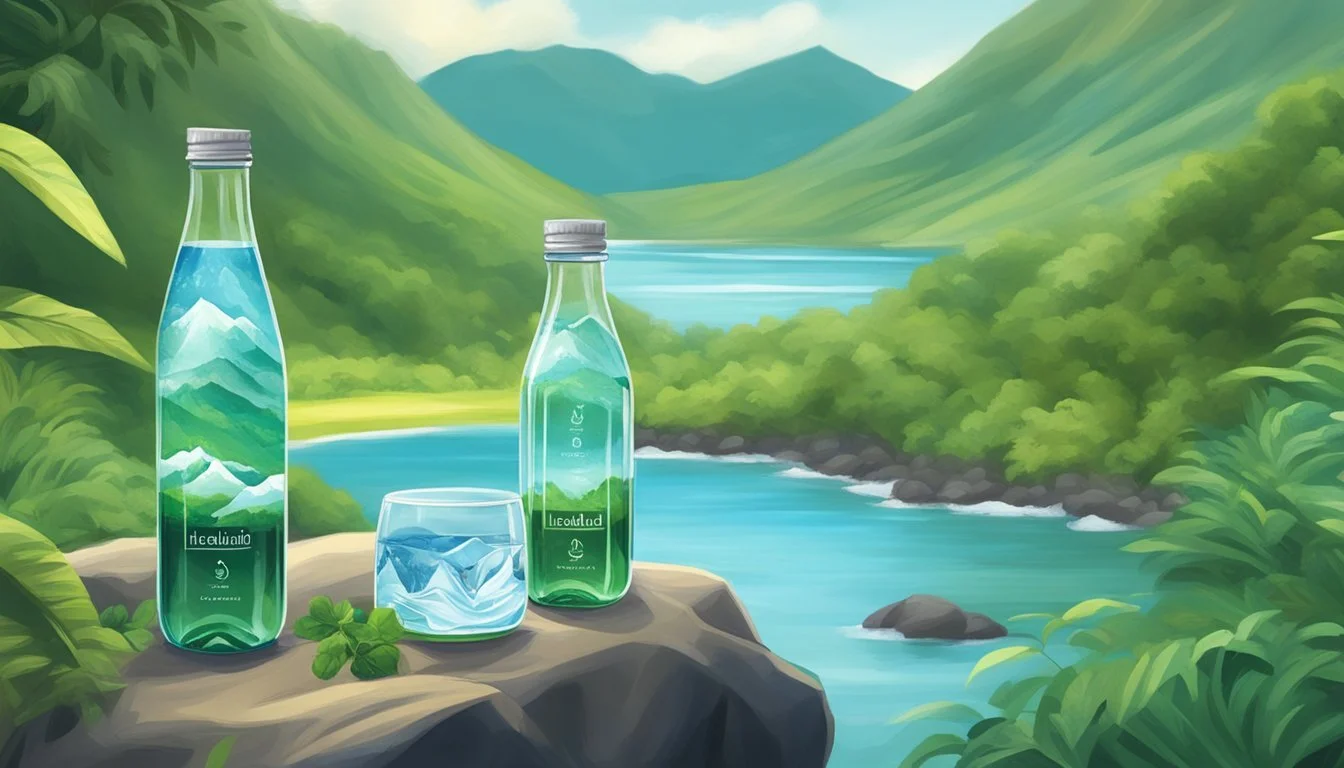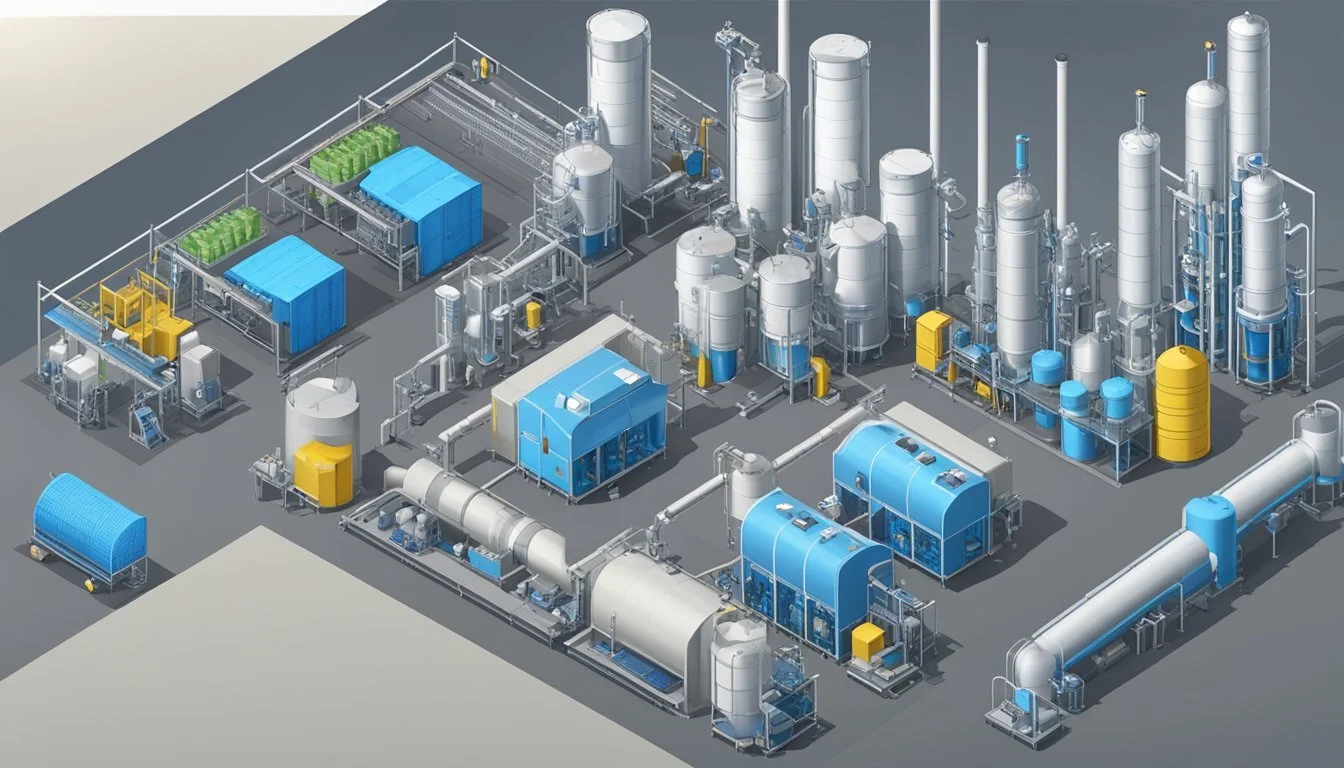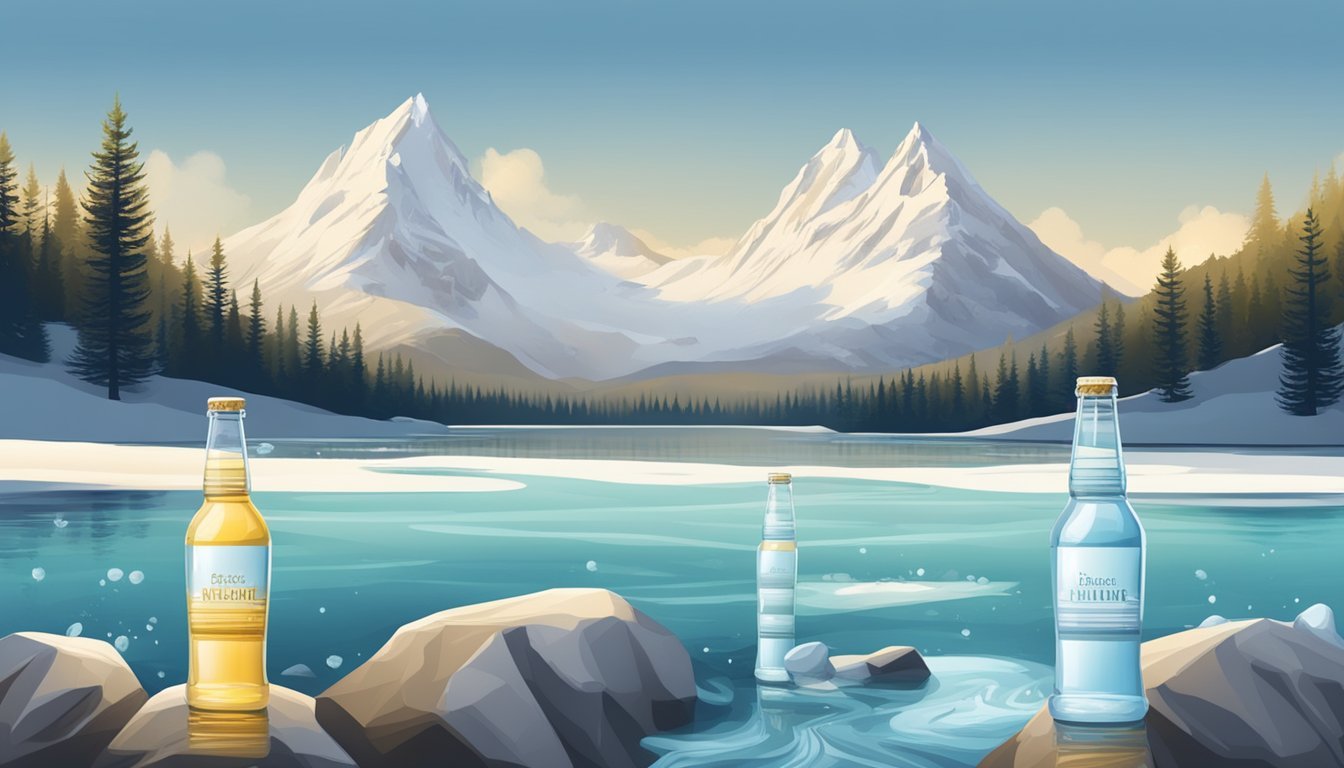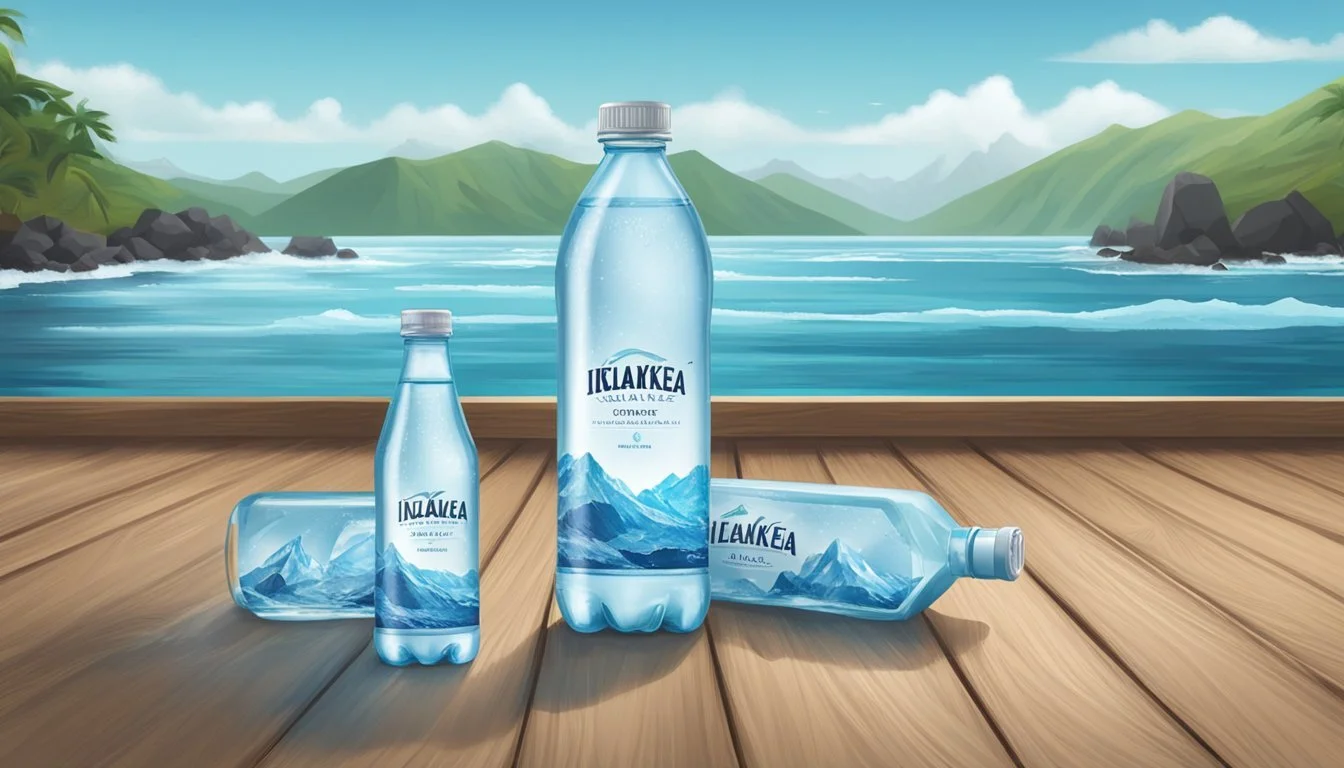Icelandic Glacial vs. Waiakea
Ultimate Bottled Water Showdown
When it comes to premium bottled water, two brands often stand out: Icelandic Glacial and Waiakea. These brands promise high quality and unique properties, sourced from distinct natural environments. Icelandic Glacial is known for its purity and balanced mineral content, coming from the pristine springs of Iceland. With its pure taste and pH level of 8.4, it delivers a refreshing hydration experience that many aficionados swear by.
Waiakea, on the other hand, distinguishes itself with its volcanic filtration. Sourced from Hawaii, Waiakea water offers a slightly alkaline pH of 8.2 and is enriched with minerals from volcanic rocks. This unique filtration process gives it a crisp, clean taste that's hard to match.
For those weighing their choices, the subtle differences in taste and mineral content could be the deciding factors. While both brands offer high-quality hydration, the choice ultimately depends on individual preference and what specific benefits one seeks from their bottled water.
Overview of Bottled Water Industry
The bottled water industry has experienced substantial growth worldwide. Increasing demand for convenient hydration has fueled a surge in consumption. Consumers often perceive bottled water as a healthier alternative to sugary beverages.
Bottled waters come in various forms such as spring, mineral, and purified water. Each type offers distinct attributes. Mineral content and pH levels often distinguish these categories.
Health and hydration are significant selling points. Brands frequently highlight the purity of their water sources and the presence of beneficial minerals. Icelandic Glacial, for instance, emphasizes its balanced mineral content. Waiakea stands out for its alkaline pH level and sustainability practices.
Sustainability is emerging as a crucial factor. Companies like Waiakea are setting examples by becoming Carbon Neutral. They aim to reduce environmental impact while meeting consumer demands.
Key Players in the industry include both global giants and niche brands. Major brands such as Aquafina and Pure Life are widely recognized, while premium brands like Icelandic Glacial carve out their niche with quality and origin stories.
Technological advancements have also influenced the industry. Processes like micro-filtration and reverse osmosis ensure high purity levels. Enhanced filtration and ionization processes result in products like alkaline water, with brands like Essentia achieving a pH of 9.5 or higher.
Ultimately, the bottled water industry is a dynamic and evolving market. It blends consumer preferences for health and hydration with increasing demand for sustainability and purity.
Comparing Water Sources
Icelandic Glacial and Waiakea Water both boast pristine sources, but they have distinct differences that set them apart. Key aspects like the origin of their water and the environmental impact of their sources can help consumers make an informed choice.
Natural Spring vs. Artesian Aquifer
Icelandic Glacial Water originates from the Ölfus Spring in Iceland. This natural spring is known for its purity and low mineral content. The water is filtered through layers of lava rock, giving it a clean taste.
On the other hand, Waiakea Water comes from an artesian aquifer, fed by snowmelt and rain filtering through porous volcanic rock around the Mauna Loa volcano in Hawaii. The volcanic filtration process enriches the water with naturally occurring minerals and electrolytes, contributing to its slightly alkaline pH.
Both sources ensure minimal human interference, but the differences in filtration methods highlight the unique characteristics of each.
Impact of Environmental Source
Icelandic Glacial takes pride in sustainable practices, operating from a carbon-neutral facility. The spring is monitored to ensure the ecosystem remains untouched, which helps maintain the water's quality and purity.
Waiakea's source, influenced by the Mauna Loa volcano, benefits from a highly renewable water supply due to frequent rainfall in Hawaii. They donate a portion of revenue to local nonprofits, emphasizing environmental conservation. Additionally, Waiakea is certified Carbon Neutral, showcasing a commitment to reducing its ecological footprint.
Both brands demonstrate a strong focus on sustainability, but their differing geographical locations and environmental efforts offer unique benefits to eco-conscious consumers.
Chemical Composition and Mineral Content
Icelandic Glacial and Waiakea waters both offer unique chemical compositions that affect their taste, health benefits, and pH levels. This section breaks down their mineral content and how it impacts various aspects of the water.
Mineral Impact on Taste and Health
Icelandic Glacial has a low mineral content with a Total Dissolved Solids (TDS) of 62 ppm. This means it contains fewer minerals such as magnesium, calcium, and potassium, making it a pure option that does not overcrowd the palate. This low mineral content can result in a cleaner taste.
Waiakea Water comes from Hawaiian volcanic sources and offers a higher level of minerals. It includes notable amounts of calcium, magnesium, potassium, and silica, which contribute to its health benefits. The presence of these minerals aids in hydration and provides essential electrolytes needed for bodily functions.
Both waters contain bicarbonate, which aids in maintaining pH balance. While Icelandic Glacial is valued for its purity, Waiakea’s mineral content is beneficial for those seeking additional health benefits from their drinking water. Despite these differences, neither water contains harmful levels of sodium or fluoride.
Understanding pH Levels in Bottled Water
Icelandic Glacial has a naturally occurring pH level around neutral, approximately 7.4, which supports the body's natural pH balance. This neutrality might appeal to those looking for water that does not alter the body's acidity levels.
Waiakea Water is alkaline with a pH level of around 8.2. This alkaline nature is achieved through natural filtration and mineral content, especially from volcanic rock. The higher pH level can help neutralize acid in the body, which is often sought after for its potential health benefits.
The difference in pH levels between these two brands is essential for consumers considering the impact on their body's acid-alkaline balance. Those preferring neutral water might lean towards Icelandic Glacial, while individuals seeking alkaline attributes could favor Waiakea.
Health Benefits and Concerns
When comparing Icelandic Glacial and Waiakea bottled water, several health benefits and potential risks become apparent. These waters can enhance hydration and various bodily functions while raising concerns about impurities and contaminants.
Hydration and Bodily Functions
Both Icelandic Glacial and Waiakea water are noted for their hydration benefits. Icelandic Glacial boasts an alkaline pH level of 8.4, which can aid in maintaining a balanced pH in the body. This can support bone health, digestion, and blood viscosity.
Waiakea water stands out with its naturally high alkaline pH of 8.8. This helps neutralize stomach acidity and supports bodily functions like immune system performance and detoxification. The mineral content in both waters aids in reducing inflammation and promoting overall health.
Potential Risks and Impurities
While both water brands are renowned for their purity, potential risks exist. Icelandic Glacial water is sourced from the Olfus Spring, filtered naturally through lava fields, ensuring minimal impurities. Despite stringent testing, concerns about environmental impact and cost remain.
Waiakea water, sourced from Hawaiian volcanic rock, is also praised for its purity. Naturally low in contaminants, it has undergone certification to ensure safety. The primary consideration with both brands is their environmental footprint due to packaging and transport.
Neither water brand has significant issues with aftertaste, making both attractive options for those valuing hydration and purity.
Taste Profile Analysis
Icelandic Glacial and Waiakea are both renowned brands in the bottled water market, each offering distinct taste profiles.
Icelandic Glacial is celebrated for its notably clean and crisp taste. The water is sourced from an ancient spring in Iceland and is naturally low in minerals. This results in a smooth taste with no detectable aftertaste.
Waiakea water distinguishes itself with a more complex taste. Sourced from the Mauna Loa volcano in Hawaii, it contains natural minerals that give it a slightly sweet undertone. Some drinkers might notice a subtle volcanic aftertaste, adding a unique character to the water.
Brand Taste Sweetness Aftertaste Icelandic Glacial Clean, crisp None None Waiakea Complex Slightly sweet Subtle, volcanic
Those who prefer a neutral taste free from any sweetness or aftertaste might lean towards Icelandic Glacial.
On the other hand, drinkers looking for a minimally sweet and unique flavor experience might favor Waiakea.
Each brand maintains high purity standards, ensuring that the taste is not compromised by contaminants. The essential difference lies in the mineral content and the resulting taste profile.
Both waters are well-regarded, but individual preferences play a significant role in determining the favored brand.
Sustainability and Environmental Impact
Both Icelandic Glacial and Waiakea prioritize sustainability through their environmental practices. This section examines their approaches to reducing the carbon footprint and the types of packaging materials they use.
Bottled Water and Carbon Footprint
Icelandic Glacial is marketed as the first bottled water to be certified CarbonNeutral. They achieve this by using renewable energy sources for their production and investing in carbon offset initiatives. Additionally, their water is naturally filtered through volcanic rock, which further minimizes the energy required for purification.
Waiakea takes a robust approach to sustainability by not only being CarbonNeutral but also donating over 5% of its revenue to non-profit organizations dedicated to environmental causes. They have been recognized for their low carbon emissions and commitment to reducing their environmental impact through various ecological programs.
Packaging Materials and Recycling
Icelandic Glacial uses 100% recyclable BPA-free PET bottles. This reduces the environmental pollution typically associated with regular plastic bottles. Their packaging minimizes waste and supports a circular economy by ensuring that materials can be reused indefinitely without losing quality.
Waiakea, on the other hand, stands out by utilizing high-grade 100% post-consumer recycled PET (rPET). These bottles consume 85% less energy in their production process, use 99% less water, and cut carbon emissions by 79% compared to virgin plastic. The use of rPET underscores their commitment to sustainability, packaging innovation, and reducing plastic pollution.
Production and Purification Processes
The production and purification processes for Icelandic Glacial and Waiakea bottled waters highlight their distinct approaches to ensuring quality and purity, which include the use of natural sources and specific filtration methods.
Filtration and Ionization Techniques
Icelandic Glacial water originates from the Ölfus Spring, a natural alkaline spring that provides naturally filtered water. Unlike many other brands, Icelandic Glacial doesn't rely heavily on industrial purification; its water is naturally filtered through lava rock, ensuring a balance of essential minerals like calcium and magnesium. During bottling, minimal additional processing is done to preserve its natural integrity.
Waiakea, sourced from volcanic rock filters in Hawaii, also boasts natural filtration. The water travels through thousands of feet of porous volcanic rock, naturally enriching it with minerals and electrolytes. While Waiakea focuses on maintaining the natural properties of the water, it also undergoes additional purification processes to ensure safety and consistency without eliminating its beneficial minerals.
Standards and Regulations
Both Icelandic Glacial and Waiakea adhere to stringent standards and regulations to ensure their bottled water is safe for consumption. Icelandic Glacial complies with FDA standards and European Union regulations, guaranteeing that its water meets rigorous quality benchmarks. The emphasis is on maintaining the natural purity of the water while ensuring it is free from contaminants.
Waiakea follows similar regulatory guidelines, including those set by the FDA, to ensure the bottled water meets health and safety standards. Furthermore, Waiakea’s eco-friendly practices, such as using sustainable packaging, align with its commitment to environmental responsibility. Both brands prioritize stringent regulatory compliance to deliver high-quality, safe, and pure bottled water to consumers.
Comparative Health Influence
Both Icelandic Glacial and Waiakea water offer health benefits due to their natural mineral content and high pH levels. These benefits are especially significant concerning alkaline water advantages and acid reflux management.
Alkaline Water Benefits
Alkaline water, such as Icelandic Glacial (pH 8.4) and Waiakea (pH 7.6-8.2), provides essential minerals and electrolytes. This can help maintain proper hydration levels, more effectively than regular water. They also contribute to overall body balance, potentially reducing acidity in the bloodstream.
Minerals like silica, found in Waiakea, support bone, hair, skin, nail, and heart health. Icelandic Glacial is rich in naturally occurring minerals without artificial enhancement. Other brands like Essentia (pH 9.5) and BodyArmor SportWater also offer high pH levels but may not have the same natural mineral content.
Acid Reflux and Alkalinity
A high pH level in water may help reduce symptoms of acid reflux. By neutralizing stomach acid, alkaline water can provide relief to those suffering from this condition. Icelandic Glacial and Waiakea water can both be beneficial for managing acid reflux due to their alkaline nature.
Studies suggest that consuming water with a higher pH helps to deactivate pepsin, the main enzyme causing acid reflux. While other brands like pHure Alkaline Water and Essentia also provide high pH values, the natural mineral content in Icelandic Glacial and Waiakea may offer additional benefits. Their unprocessed nature means there’s no compromise on the quality of water consumed for acid reflux.
Brand Perception and Marketing
Both Icelandic Glacial and Waiakea have unique strategies for shaping public perception and positioning themselves in the competitive bottled water market. Key factors include their associations with celebrities and their distinct market positioning.
Celebrity Endorsements and Influence
Icelandic Glacial has effectively utilized celebrity endorsements to enhance its brand image. High-profile figures such as Gwyneth Paltrow and Reese Witherspoon have been seen publicly enjoying the product. This association helps the brand convey an image of sophistication and purity, appealing to consumers who follow celebrity trends.
Waiakea also harnesses the power of celebrity endorsements, leveraging figures known for their health-conscious lifestyles. Celebrities like Jason Momoa, who is linked with sustainable and health-driven choices, have been noted promoting Waiakea. This strengthens Waiakea's branding as both a premium and environmentally responsible choice.
Market Positioning and Consumer Preference
Icelandic Glacial markets itself as the purest choice, sourced from ancient Icelandic springs. Positioned as a luxury brand, it competes with other high-end waters like Evian and Fiji. It appeals primarily to consumers looking for a blend of purity, sustainability, and a connection to celebrity culture.
Waiakea, on the other hand, highlights its Hawaiian roots and environmental initiatives. Its naturally alkaline water and use of 100% recyclable rPET bottles attract eco-conscious consumers. Waiakea's focus on health benefits and sustainability has carved out a niche market, competing with brands like Essentia Water.
Both brands use distinct marketing strategies that cater to different aspects of consumer preference, allowing them to thrive in a highly competitive industry.
Cost Analysis
When comparing the cost of Icelandic Glacial and Waiakea bottled water, several factors come into play.
Price per Bottle:
Icelandic Glacial typically retails around $1.50 for a 500ml bottle. Waiakea, on the other hand, averages approximately $2.00 for the same size.
Subscription and Bulk Options:
Both brands offer subscription and bulk purchasing options. Icelandic Glacial offers discounted rates for bulk purchases, often reducing the per-bottle cost to $1.20. Waiakea's subscription service reduces costs to about $1.80 per bottle.
Economic Factors:
The pricing reflects their source and processing methods. Icelandic Glacial water is sourced from Icelandic springs, while Waiakea water comes from Hawaiian volcanic rock filtration systems.
Packaging:
Icelandic Glacial uses recycled plastic bottles with a focus on sustainability. Waiakea promotes eco-friendly practices with high-quality, carbon-neutral certified packaging.
Convenience:
Both brands are widely available online and in major retail stores. Icelandic Glacial is often found in more international markets, whereas Waiakea has a stronger presence in the United States and select international locations.
Overall Availability:
Convenience may slightly favor Icelandic Glacial due to its widespread availability. Waiakea, with its higher price point, targets a niche market prioritizing premium quality and sustainability.
Comparatively, while Waiakea offers more eco-friendly practices, Icelandic Glacial provides a more budget-friendly option. Both cater to consumers looking for premium bottled water with specific economic and convenience considerations.
Final Thoughts and Recommendations
When choosing between Icelandic Glacial and Waiakea bottled water, it's essential to consider key aspects that impact well-being and personal preferences.
Taste and Purity
Icelandic Glacial offers a crisp and clean taste, attributed to its pure, natural spring source. Waiakea’s taste is lighter and slightly crisper due to volcanic filtration, which can add beneficial minerals.
Source and Sustainability Icelandic Glacial water comes from Icelandic springs, replenished by natural rainfall and snowmelt. Waiakea is sourced from Hawaiian volcanic rock, which filters the water naturally. Both brands use eco-friendly practices, ensuring their sources are sustainable.
Health Benefits Icelandic Glacial maintains natural mineral content, promoting hydration with a balanced pH. Waiakea includes silica, known for its benefits to hair, skin, and nails, alongside other essential minerals that contribute to overall wellness.
Packaging Both brands prioritize sustainability. Icelandic Glacial uses BPA-free, 100% recyclable rPET bottles. Waiakea also uses BPA-free bottles made from 100% RPET, highlighting their commitment to environmental responsibility.
Cost and Accessibility Icelandic Glacial may be more widely available and has strong reviews emphasizing taste and purity. Waiakea offers competitive pricing and distinctive health benefits, potentially appealing to those seeking specific wellness advantages.
Given all factors, the choice largely depends on individual priorities—whether it’s taste, mineral content, or environmental impact. Both brands offer high-quality options for mindful consumers.
More About Icelandic Glacial
Acqua Panna vs Icelandic Glacial: Which Bottled Water is Better?
Aquafina vs Icelandic Glacial: Which Bottled Water is Better?
Arrowhead vs Icelandic Glacial: Which Bottled Water is Better?
Boxed Water vs Icelandic Glacial: Which Bottled Water is Better?
Core Hydration vs Icelandic Glacial: Which Bottled Water is Better?
Deer Park vs Icelandic Glacial: Which Bottled Water is Better?
Essentia vs Icelandic Glacial: Which Bottled Water is Better?
Eternal vs Icelandic Glacial: Which Bottled Water is Better?
Ice Mountain vs Icelandic Glacial: Which Bottled Water is Better?
Icelandic Glacial vs 1907water: Which Bottled Water is Better?
Icelandic Glacial vs 7-Select: Which Bottled Water is Better?
Icelandic Glacial vs Alkaline88: Which Bottled Water is Better?
Icelandic Glacial vs Antipodes: Which Bottled Water is Better?
Icelandic Glacial vs Aqua Carpatica: Which Bottled Water is Better?
Icelandic Glacial vs Big Chill: Which Bottled Water is Better?
Icelandic Glacial vs Big Win: Which Bottled Water is Better?
Icelandic Glacial vs BodyArmor: Which Bottled Water is Better?
Icelandic Glacial vs Cascade Mountain: Which Bottled Water is Better?
Icelandic Glacial vs Castle Rock: Which Bottled Water is Better?
Icelandic Glacial vs CBD Living: Which Bottled Water is Better?
Icelandic Glacial vs Crystal Geyser: Which Bottled Water is Better?
Icelandic Glacial vs Crystal Lake: Which Bottled Water is Better?
Icelandic Glacial vs Erewhon: Which Bottled Water is Better?
Icelandic Glacial vs Essence pH10: Which Bottled Water is Better?
Icelandic Glacial vs Hawaii Volcanic: Which Bottled Water is Better?
Icelandic Glacial vs Hawaiian Springs: Which Bottled Water is Better?
Icelandic Glacial vs Just Water: Which Bottled Water is Better?
Icelandic Glacial vs Kirkland Signature: Which Bottled Water is Better?
Icelandic Glacial vs LIFEWTR: Which Bottled Water is Better?
Icelandic Glacial vs Liquid Death: Which Bottled Water is Better?
Icelandic Glacial vs Mananalu: Which Bottled Water is Better?
Icelandic Glacial vs Mountain Valley Spring Water: Which Bottled Water is Better?
Icelandic Glacial vs Nestle Pure Life: Which Bottled Water is Better?
Icelandic Glacial vs Open Water: Which Bottled Water is Better?
Icelandic Glacial vs Perrier: Which Bottled Water is Better?
Icelandic Glacial vs Poland Spring: Which Bottled Water is Better?
Icelandic Glacial vs Proud Source: Which Bottled Water is Better?
Icelandic Glacial vs Pure Life: Which Bottled Water is Better?
Icelandic Glacial vs Purely Sedona: Which Bottled Water is Better?
Icelandic Glacial vs Refreshe: Which Bottled Water is Better?
Icelandic Glacial vs Richard's Rainwater: Which Bottled Water is Better?
Icelandic Glacial vs San Pellegrino: Which Bottled Water is Better?
Icelandic Glacial vs Simple Truth: Which Bottled Water is Better?
Icelandic Glacial vs Smartwater: Which Bottled Water is Better?
Icelandic Glacial vs Solan de Cabras: Which Bottled Water is Better?
Icelandic Glacial vs Starkey: Which Bottled Water is Better?
Icelandic Glacial vs Talking Rain AQA: Which Bottled Water is Better?
Icelandic Glacial vs The Well: Which Bottled Water is Better?
Icelandic Glacial vs Topo Chico: Which Bottled Water is Better?
Icelandic Glacial vs Tru Alka: Which Bottled Water is Better?
Icelandic Glacial vs Weird Water: Which Bottled Water is Better?
Icelandic Glacial vs Whole Foods 365: Which Bottled Water is Better?
Icelandic Glacial vs Whole Foods Italian Still Mineral water: Which Bottled Water is Better?
Icelandic Glacial vs Zephyrhills: Which Bottled Water is Better?
Icelandic Glacial vs HFactor: Which Bottled Water is Better?








